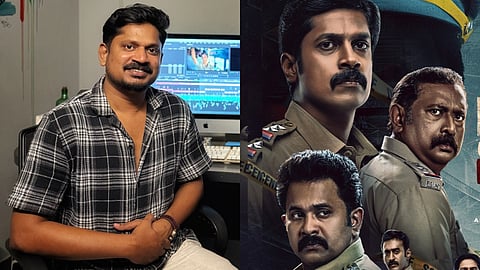Mahesh Bhuvanend: Editing is not just about software, it’s understanding emotions
At 39, editor Mahesh Bhuvanend has come a long way from his early days in Mannarkkad, Palakkad, where he first imagined a life behind the edit desk. After his television stint with Asianet and Mazhavil Manorama—a period when he spent evenings assisting editors like Vivek Harshan and Nishadh Yusuf and quietly shaping trailers. It was in those corridors that he crossed paths with filmmaker Ahammed Khabeer, then an assistant director, sparking a creative partnership that would eventually span Madhuram and Kerala Crime Files. Last year, Mahesh’s superb work on Aattam, a film built almost entirely on conversation, earned him the National Award for Best Editing. As the second season of Kerala Crime Files is streaming on JioHotstar, he talks about crafting its episodic structure, balancing emotion and suspense, his penchant for cutting trailers, and more.
Excerpts:
Coming to Kerala Crime Files, editing a series has an episodic structure that brings unique challenges. How do you handle these compared to editing a feature film?
In a feature film, there’s only a first half and a second half. In a two-and-a-half-hour film, each half is about an hour. It’s a challenge to keep it engaging as the audience watches it all in one go. If it loses momentum in the middle, it affects the experience. In a series, there’s a natural break every half-hour. It can be tricky to package each half-hour well, but having that shorter duration makes it easier to judge and shape. That’s a big advantage.
In the second season, the non-linear storytelling shows misleading glimpses of the culprit, only revealing the truth at the end. How do you keep it engaging without confusing the audience?
Sometimes, when you start reading a script, you stop at night and continue the next day. But when I read Bahul’s script for Kerala Crime Files 2, I started at 10 at night and read it completely before going to sleep. With a script like that, you feel the thrill of wanting to know what happens next. That gives you confidence that the audience will feel the same. When we look at the footage, there are visuals we’ve already imagined. So I edited it with the same excitement I felt during my first reading. The way viewers might have mistaken the red herrings as someone else’s past was exactly how I felt too. Another interesting aspect this season is the presence of subplots. Each layer had its own emotional beats, and balancing them was important. A challenge with any second season, especially a police procedural, is that it has to be just as powerful, if not more, in showing the growth of the main characters. In that way, there was an advantage, because this season starts with a new police officer, Noble (played by Arjun Radhakrishnan), and we, like the audience, don’t know him yet.
Even though the team had a clear vision during pre-production, were there still any improvisations on the editing table?
Definitely, because when you sit down to edit, something changes. The structures you create can shift, and the way scenes are told can be adjusted. The advantage this season was that the script already felt like an edited version. All the non-linear elements were assembled in a way that resembled a finished cut. In a series, you can’t really shuffle content between episodes. You can only move things around within each episode. So here, it was mainly trimming or rearranging scenes inside episodes.
Like Kishkindha Kaandam, Bahul Ramesh wrote this season on a need-to-know basis, with much left between the lines. Did that make editing more challenging?
No. What excited me most about Bahul’s script is that when we move from one scene to the next, the person in the new scene doesn’t start by saying something completely fresh. They continue from what was said earlier. While editing, you feel as if that person was already there before. That was a first-time experience for me. Usually, new characters arrive with exposition explaining who they are, but this script avoided that. Also, we didn't follow the style where episodes end and begin at the same point. Even when big questions were left hanging, we tried to lighten the mood before giving answers.
Looking beyond Kerala Crime Files, you recently won the National Award for your work on Aattam, a film driven largely by dialogue. How challenging was it to edit a conversation-heavy film like that?
When Anand (Ekarshi) told me the story, I really liked it. Aattam is about 10 to 13 people coming together in one place, and as the audience, we’re like the 14th person standing among them. That was the feeling I got when I read it. Another interesting thing is that we can tell when the characters are lying. We see it all as a spectator. From my first reading, I knew the editor also had to be that 14th person. Otherwise, it wouldn’t work. The biggest challenge was moving the character arcs forward. Every person starts out decent, but at some point, they begin to change. Their behaviour shifts a lot, and they start speaking according to their own needs. There’s a clear character graph, and you have to maintain it for everyone. When all the characters reach a certain tension, no reaction should fall flat. You have to guide all 13 characters through the film.
Could you share what it was like to receive the National Award?
Receiving an award from the President is a huge achievement. I can’t really explain it in words. When the film was sent for the State Awards, we didn’t get anything. Later, Anand called to say the media were contacting him about Aattam winning the National Award. I casually told him I didn’t believe it, though deep down, I hoped the film would get recognition. It had already been appreciated at festivals. When the award was announced, Anand, Ahammed and I were together in my studio. First, my award was announced, then Anand’s for Best Script, and finally Best Film. It was a great moment. Standing in the queue and then going on stage to receive the award, I felt a mix of pride and nervousness. It was such a big moment, and I kept thinking there’s nothing bigger than this to achieve in India. The weight of that made me a little scared. (smiles)
You still cut trailers for films you haven’t edited yourself. Could you talk us through that process and the unique challenges? Do you usually get the full footage when working on trailers?
What I do is take the entire edited timeline of the film, with all the locked footage. We watch the whole film and then make a 2.5-minute trailer from that. It’s an interesting process. We don’t want to leave out the core idea but have to create something that intrigues audiences without spoiling anything. The trailer cut is completely my personal choice. That’s my biggest high in cutting trailers. Of course, sometimes there will be suggestions that certain bits might be spoilers. Even then, the overall design stays the same.
For Mohanlal's Thudarum, the trailer you cut makes it feel almost like a different film when you watch it....
Thudarum was first marketed as a family film. That’s how Tharun (Moorthy) and Renjith ettan positioned it. When the footage came to me, they both said we shouldn’t reveal anything that would give away the real mood of the film, though there should be a small hint at the end. That’s how we did the first trailer. They also said we’d do a second trailer with more elements after the release, but that too had to stay in a safe zone so more people would feel intrigued. That’s how we did the second trailer, from which Lalettan’s iconic jump became viral.
When we look at trailers in other languages, especially Hindi, the whole story is often revealed in just three minutes…
I think outside Malayalam, there’s a tendency to show off production values and highlight the beauty of the shots. In Malayalam, we create trailers with more respect for the content itself. Elsewhere, they showcase everything and then do business around that. Their trailers are mainly for pre-release deals. They show everything in those three minutes to close the business side. But here, it’s not like that. We don’t make trailers for pre-business. We make them to bring people to cinemas by sparking curiosity. That’s the difference.
What advice would you offer aspiring editors?
It’s not enough to just learn the software. Editing is storytelling. You need to understand the depth of the story and interpret the emotions of the characters before you sit down to edit. Some people miss this, and I always tell that to those who assist us. If the script is strong, read it thoroughly and understand the emotions. Only then can you edit a scene properly. Otherwise, what the script conveys and what the audience receives can be completely different. You shouldn’t divide scenes purely based on how beautiful the shot looks. If you only focus on that, you’ll lose the flow of the story. There’s no point saying the making is good if you can’t communicate it effectively.

